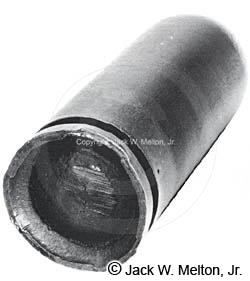The authors feel that an area of potential confusion exists
in the ability to tell the difference between a smooth-sided Confederate Read-Parrott and
a Federal Read-Parrott projectile. Base views of both projectiles are pictured here for
comparison. On the reader's right is a Confederate manufactured Read-Parrott, which can be
identified by the lathe dimple in the base of the projectile body, a thinner wrought iron
ring sabot, and lathing marks that run the entire length of the cylindrical body. Although
difficult to see in this particular photograph, the slope, angle, and the space between
the wrought iron ring sabot and bottom of the cylindrical body is slightly different in
appearance than that of the Federal projectile on the reader's left. The Federal
Read-Parrott projectile exhibits a large chiseled area on the base where the gate waste
was removed after casting. Also note there is no evidence of a lathe dimple, since the
cylindrical body was not machine-turned. The wrought iron ring is thicker and pre-stamped
with corresponding rifling projections (pre-rifled) in nearly all Federal Read-Parrott
projectiles; only rarely do Confederate Read-Parrott projectiles exhibit similar
pre-stamped projections (pre-rifling).
Differences can also be seen when comparing the commonly found fuzes. The Confederate Read
projectile is most often found with a wooden fuze plug or a copper fuze plug adapter. The
Federal Read-Parrott projectile is commonly found with a white metal Parrott fuze plug
made of zinc.
We hope the above information helps the collector to determine the correct pattern of a
questionable projectile. There is, however, no substitute for hands-on experience.
Go here for a Confederate Read-Parrott projectile, and here for a Federal Read-Parrott projectile. For more information
concerning Read vs. Parrott, go here. For
more information about Dr. John Read click here
and for more information about Robert Parrott click here. |

